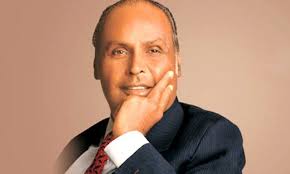Biography of Dhirubhai Ambani in english
).jpg)
In the history of modern India, few names shine as brightly as that of Dhirubhai Ambani. From a modest beginning in a small village of Gujarat to becoming the founder of one of India's largest conglomerates — Reliance Industries — his story is nothing short of legendary. Dhirubhai didn't just build a business empire; he shaped a new culture of entrepreneurship in India. This biography traces the journey of a visionary who dared to dream big and changed the face of Indian business forever.
Field |
Details |
Name |
Dhirubhai Ambani |
Image |
|
Caption |
Dhirubhai Ambani: The Visionary Who Transformed Indian Business |
Birth Name |
Dhirajlal Hirachand Ambani |
Birth Date |
28 December 1932 |
Birth Place |
Chorwad, Junagadh district, Gujarat, India |
Death Date |
6 July 2002 |
Death Place |
Mumbai, Maharashtra, India |
Resting Place |
Juhu Cemetery in Mumbai, |
Nationality |
Indian. |
Citizenship |
Indian. |
Occupation |
Industrialist
|
Years Active |
1950–2002. |
Known For |
Pioneering the Indian private sector |
Spouse(s) |
Kokilaben Ambani. |
Children |
Mukesh Ambani (son)
|
Parents |
Father: Hirachand Gordhanbhai Ambani
|
Early Life and Family Background
Dhirajlal Hirachand Ambani, affectionately known as Dhirubhai, was born on 28 December 1932 in Chorwad, a small village in the Junagadh district of Gujarat. He belonged to a middle-class Modh Baniya family. His father, Hirachand Gordhanbhai Ambani, was a school teacher, and his mother, Jamnaben Ambani, was a homemaker. Dhirubhai was the second of five children.
Life in Chorwad was far from easy. The family had limited financial resources, and the children were taught to live within their means. However, even in his childhood, Dhirubhai displayed signs of ambition and an enterprising spirit. He was not academically brilliant, but his sharp mind and street-smart attitude made him stand out.
Early Career and Move to Aden
Due to financial constraints, Dhirubhai had to quit studies early. At the age of 17, he left for Aden (present-day Yemen), then a British colony, to work and support his family. He got a job at A. Besse & Co., a trading firm that dealt in petroleum products, textiles, and other goods. He started as a clerk but quickly learned the basics of trade, exports, foreign currency, and shipping.
His exposure to international markets in Aden was instrumental in shaping his business acumen. He also observed the workings of British firms and learned about capitalism, stock markets, and large-scale trade. Aden also gave him his first taste of entrepreneurship — he began selling pakoras to supplement his income and even started trading silver coins when the opportunity arose.
But he was not content with a salaried job. In his heart, he nurtured the dream of starting his own business in India.
Return to India and the Birth of Reliance
In 1958, Dhirubhai Ambani returned to Mumbai (then Bombay) with savings of around Rs. 15,000. He partnered with Champaklal Damani, his second cousin, to start Reliance Commercial Corporation, a small trading business operating from a modest office in Masjid Bunder.
Initially, they dealt with the import of polyester yarn and export of spices. While Damani was conservative in approach, Dhirubhai was aggressive and willing to take risks. Eventually, due to differences in vision, the partnership ended in 1965, and Dhirubhai started building his own empire independently.
He had set his eyes on the booming textile market. He realized that polyester, a synthetic fiber, had the potential to revolutionize the Indian textile industry. It was durable, cheaper, and easier to produce compared to traditional cotton fabrics.
The Rise of Reliance Textiles and the Vimal Brand
In 1966, Dhirubhai set up his first textile mill in Naroda, near Ahmedabad, Gujarat. This was the birth of Reliance Textiles Industries. He named his brand Vimal, after his nephew. Vimal fabrics soon became known for their quality, style, and affordability.
To market Vimal, Dhirubhai used innovative techniques. He launched bold advertising campaigns with slogans like “Only Vimal”, which captured public attention. He set up an extensive distribution network and created a strong retail presence across India. Vimal became a household name, and Reliance’s reputation grew rapidly.
The IPO That Changed India
One of Dhirubhai’s most revolutionary moves came in 1977, when Reliance Industries went public. At a time when the Indian stock market was seen as a playground for the elite, Dhirubhai brought equity investment to the common man. He actively encouraged middle-class Indians to invest in Reliance, often addressing large shareholder gatherings and treating small investors like family.
The IPO was a massive success, and thousands of people became shareholders in Reliance. Dhirubhai created a new culture — the “equity cult” — in India. Over time, Reliance became one of the most widely held stocks on the Indian stock exchange.
His success in managing public funds, fulfilling investor expectations, and maintaining transparency made him a legend among retail investors.
Diversification and Rapid Growth
Throughout the 1980s and 1990s, Reliance diversified into various sectors, including:
Petrochemicals
Plastics
Energy
Oil and Gas Exploration
Telecommunications
Infrastructure
Dhirubhai’s approach was to integrate backward and forward — meaning Reliance didn’t just make finished products but also produced raw materials and controlled distribution. This reduced costs and increased efficiency.
He also had a keen sense of timing. When India opened up its economy in 1991, Reliance was ready to take full advantage of liberalization. It grew faster than any other Indian company at the time.
Challenges and Controversies
Dhirubhai’s rise wasn’t without hurdles. His aggressive strategies often attracted criticism. He was accused of influencing government policies in his favor, manipulating stock prices, and engaging in unethical practices. Several media outlets and rival industrialists targeted him, most notably in the 1998 book “The Polyester Prince” by Hamish McDonald — which was controversial and banned in India at the time.
Despite these controversies, Dhirubhai always maintained that he worked within the law and focused on delivering value to investors and the nation.
Leadership Style and Philosophy
Dhirubhai Ambani’s leadership style was a mix of visionary thinking, risk-taking, and people empowerment. He believed in hiring talented individuals and giving them the freedom to perform. He encouraged innovation and was known for his sharp memory and attention to detail.
He once said:
“Think big, think fast, think ahead. Ideas are no one’s monopoly.”
Another famous quote:
“Pursue your goals even in the face of difficulties, and convert adversities into opportunities.”
His philosophy was simple: dream big, work hard, and never give up.
Family and Succession
Dhirubhai was married to Kokilaben Ambani, a strong and supportive figure in his life. Together, they had four children:
Mukesh Ambani
Anil Ambani
Nina Kothari
Dipti Salgaonkar
Both Mukesh and Anil joined Reliance in the 1980s and took on leadership roles in various divisions. Dhirubhai mentored them and gradually handed over responsibilities, though he remained the guiding force until his last breath.
Health Decline and Death
In 1986, Dhirubhai suffered his first stroke, which partially paralyzed him. However, he continued to guide the company and attend important meetings.
On June 24, 2002, he suffered a second stroke and was hospitalized. He passed away on July 6, 2002, at the age of 69, leaving the entire nation in mourning. His funeral was attended by prominent business leaders, politicians, and thousands of admirers.
Legacy and Impact
Dhirubhai Ambani left behind a legacy that continues to inspire generations. At the time of his death:
Reliance was India’s largest private-sector enterprise
It had over 2 million shareholders
It employed thousands of people across sectors
In 2016, the Government of India honored him posthumously with the Padma Vibhushan, India’s second-highest civilian award.
After His Death
After his passing, differences between his sons led to the division of Reliance in 2005. Mukesh Ambani took control of Reliance Industries Limited (RIL), while Anil Ambani formed Reliance Anil Dhirubhai Ambani Group (ADAG).
Under Mukesh’s leadership, RIL continued to grow, especially with the launch of Reliance Jio, which revolutionized India’s telecom industry. The spirit of Dhirubhai’s innovation and ambition lives on in the DNA of the company.
Influence on Indian Society
Dhirubhai Ambani wasn’t just a businessman — he was a nation builder. He democratized wealth creation, made ordinary people believe in the stock market, and showed that it was possible to rise from poverty to unimaginable success.
His story inspired millions of aspiring entrepreneurs to believe in their dreams. He proved that you didn’t need elite connections or education to succeed — just courage, vision, and relentless effort.
Conclusion
Dhirubhai Ambani’s life is a timeless story of ambition, perseverance, and innovation. From a clerk in Yemen to the architect of one of the world's most influential companies, he showed what is possible when determination meets opportunity.
He didn’t just build a business empire — he built a legacy of belief, that no dream is too big and no background too humble. His life continues to motivate every Indian who dares to dream beyond limits.
FAQ'S
1. Who was Dhirubhai Ambani?
Dhirubhai Ambani was a legendary Indian business tycoon and founder of Reliance Industries, one of India’s largest and most successful conglomerates.
2. What was Dhirubhai Ambani’s full name?
His full name was Dhirajlal Hirachand Ambani.
3. When and where was Dhirubhai Ambani born?
He was born on 28 December 1932 in Chorwad, Junagadh district, Gujarat, India.
4. What was his early life like?
Dhirubhai came from a modest background. His father was a schoolteacher. He began his career at a young age by working in Yemen as a clerk.
5. How did Dhirubhai Ambani start Reliance?
He started Reliance in the 1960s as a small textile trading company with a partner. Later, he built it into a major industrial empire.
6. What industries does Reliance operate in?
Reliance operates in petrochemicals, refining, oil and gas exploration, telecommunications (Jio), retail, and textiles.
7. What was Dhirubhai Ambani known for in business?
He was known for his vision, risk-taking ability, and mass-scale public investments through the stock market.
8. Did Dhirubhai face any controversies?
Yes, his rapid rise attracted criticism and scrutiny, including allegations of market manipulation and political connections, but none were proven conclusively.
9. When did Dhirubhai Ambani die?
He passed away on 6 July 2002 in Mumbai, Maharashtra, due to a stroke.
10. Who succeeded Dhirubhai Ambani after his death?
His two sons, Mukesh Ambani and Anil Ambani, initially managed Reliance together, but later split the business in 2005.
11. What is Dhirubhai Ambani’s legacy?
He is remembered as a pioneer of Indian capitalism, inspiring millions by showing how a man from a humble background could build a world-class business empire.
12. Are there any books or movies on Dhirubhai Ambani?
Book: "The Polyester Prince" by Hamish McDonald (banned in India).
Movie: "Guru" (2007) directed by Mani Ratnam, inspired by his life.
13. Did Dhirubhai Ambani receive any awards?
he was posthumously awarded the Padma Vibhushan in 2016, India’s second-highest civilian honor.
14. What was Dhirubhai Ambani’s business philosophy?
His philosophy included:
Think big.
Take calculated risks.
Empower common investors.
Dream with open eyes.
15. What is the Dhirubhai Ambani Foundation?
It is a philanthropic organization working in education, healthcare, and rural development, set up in his memory.
सरकारी नौकरियों, जीके अपडेट्स और करेंट अफेयर्स की ताज़ा जानकारी सबसे पहले पाने के लिए:
-
हमारे WhatsApp चैनल को फॉलो करें:
https://whatsapp.com/channel/0029Vb6sjZz0wajwDXcd5B0U -
हमारे Telegram चैनल को फॉलो करें:
https://t.me/educationmastersin -
हमारे Facebook Page को फॉलो करें:
https://www.facebook.com/educationmastersindia







.png)
.jpg)
.jpg)


